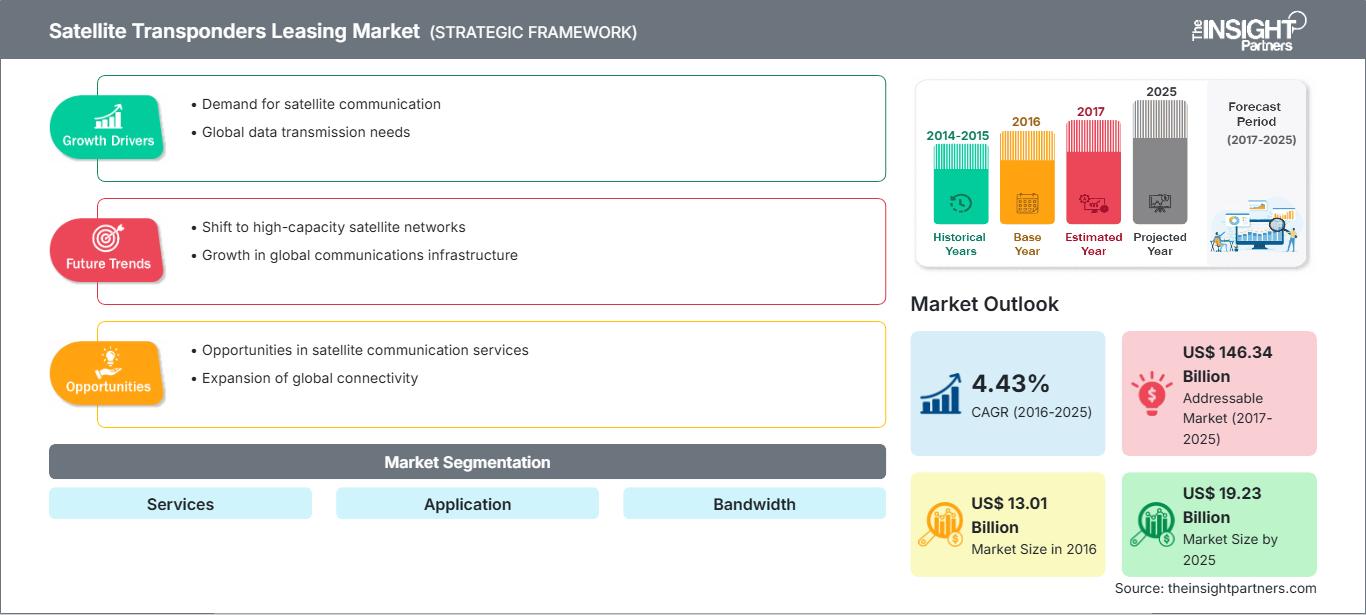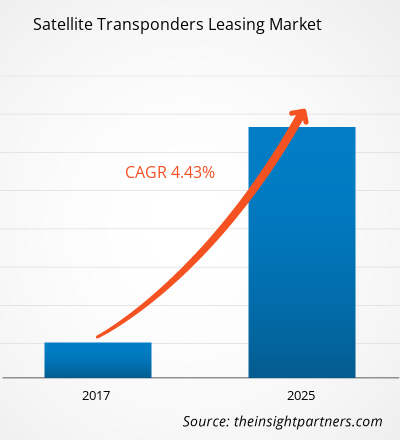Der Markt für die Vermietung von Satellitentranspondern soll von 13,01 Milliarden US-Dollar im Jahr 2016 auf 19,23 Milliarden US-Dollar im Jahr 2025 wachsen, bei einer durchschnittlichen jährlichen Wachstumsrate von 4,43 % zwischen 2016 und 2025.
Der Markt für die Vermietung von Satellitentranspondern soll sowohl hinsichtlich der Abdeckung als auch der Kapazität wachsen, da Ka-Band- und Ku-Band-Frequenzen das Marktwachstum ankurbeln. Darüber hinaus wird erwartet, dass die steigende Zahl von Abonnentenaktualisierungen und Neuabonnenten den globalen Markt für Satellitentransponder ebenfalls ankurbelt. Aufgrund der aktuellen technologischen Fortschritte in der Satellitenkommunikation werden zudem mehrere neue Anwendungen für Satellitentransponder erwartet. Diese Satelliten gelten als leistungsfähig genug, um mit der Konkurrenz, dem Digital Subscriber Line (DSL)-Breitband, mitzuhalten. All diese Faktoren dürften den globalen Markt für die Vermietung von Satellitentranspondern im Prognosezeitraum ankurbeln.Markteinblicke: Die Ausweitung der Ku-Band-Anwendungen soll neue Chancen für den Markt für die Vermietung von Kommunikationssatellitentranspondern schaffen
Liveübertragung und Videoverteilung sind einige der wichtigsten Anwendungsgebiete von Ku-Band-Satelliten; außerdem werden sie für verschiedene Datendienste verwendet, darunter VSAT-Dienste, Breitbandkonnektivität, mobiles Backhaul sowie Luft- und Seefahrtsdienste. In dieser hochvernetzten Welt gelten all diese Anwendungen als entscheidend für das Funktionieren eines Unternehmens. Tatsächlich ist das Ku-Band das wichtigste Spektrum, das von Mobilfunknetzen genutzt wird, um Breitbandkonnektivität in Bereichen bereitzustellen, die terrestrische Netze nicht erreichen können, nämlich über dem Ozean und in der Troposphäre. Das Ku-Band deckt in Bezug auf die Bandbreite etwa 40 % des Marktes ab. Die Nachfrage nach Ku-Band-Transpondern dürfte aufgrund der zunehmenden Beliebtheit von Satellitenfernsehen, insbesondere in Entwicklungsländern, steigen. HD (High Definition) und die Nachfrage nach ähnlichen Bandbreitenanwendungen werden diese Entwicklung weiter vorantreiben. Die Entwicklung von 3D-Kanälen, die eine höhere Bandbreite verbrauchen und 50 % mehr Kapazität benötigen, dürfte dem Markt für Ku-Band-Satellitentransponder neuen Schwung verleihen. Dem Ku-Band folgen die C-Band-Transponder, die derzeit den größten Marktanteil haben. Ihr Marktanteil dürfte jedoch im Prognosezeitraum stetig sinken und an Ku und ähnliche Bandbreiten verlieren. Daher wird erwartet, dass diese Expansion der Ku-Band-Anwendungen neue Möglichkeiten für den Markt für die Vermietung von Satellitentranspondern schafft.
Transponder-Leasing als Dienstleistung dominiert das globale Servicesegment des Marktes für die Vermietung von Satellitentranspondern
In den letzten ein bis zwei Jahren ist die Nachfrage nach geleasten Transpondern auf dem globalen Markt für Satellitentransponder um etwa 4,3-4,5 % gestiegen. Aufgrund der weltweit explosionsartig steigenden Transponderkosten wird mit einem weiteren Anstieg gerechnet. Auf dem Leasingmarkt für Satellitentransponder ist Europa die teuerste Region, gefolgt von Australien und Neuseeland. Südasien hingegen bietet die niedrigsten Leasingraten, weshalb der Asien-Pazifik-Raum in den kommenden Jahren als die vielversprechendste Region für den Leasingmarkt für Satellitentransponder gilt. Vor kurzem hat das koreanische Satellitenunternehmen KT SAT einen Transponder-Leasingvertrag mit einem mongolischen Satellitenfernsehbetreiber unterzeichnet. Der Dienstanbieter KT SAT hat vier Transponder gemietet, um den mongolischen Unternehmen DTH-Dienste anbieten zu können, die im kommenden Jahr eingeführt werden. Das Fernsehunternehmen DDISH TV hingegen wird voraussichtlich 2017 von den Diensten von KT SAT profitieren. Das Leasing von Kommunikationssatellitentranspondern hängt stark von der Einführung von HD-Videoübertragungen und einer weiten Verbreitung von HDR-Anwendungen (High Dynamic Range) ab. Allerdings wird erwartet, dass Leasingdienste den Markt für Satellitentransponder-Leasing mit einem relativ höchsten Marktanteil anführen werden, der jedoch Schwankungen unterliegt, die von der Änderung der Anschaffungskosten für Satellitentransponder und den Gesamtkosten für den Start eines Satelliten und dessen Wartung abhängen.
Passen Sie diesen Bericht Ihren Anforderungen an
Sie erhalten kostenlos Anpassungen an jedem Bericht, einschließlich Teilen dieses Berichts oder einer Analyse auf Länderebene, eines Excel-Datenpakets sowie tolle Angebote und Rabatte für Start-ups und Universitäten.
Markt für Satelliten-Transponder-Leasing: Strategische Einblicke

-
Holen Sie sich die wichtigsten Markttrends aus diesem Bericht.Dieses KOSTENLOSE Beispiel umfasst Datenanalysen, die von Markttrends bis hin zu Schätzungen und Prognosen reichen.
Marktinitiativen wurden als die am häufigsten angewandte Strategie im globalen Markt für Satelliten-Transponder-Leasing beobachtet. Einige der jüngsten Strategien einiger Akteure im Markt für Satelliten-Transponder-Leasing sind unten aufgeführt:
- 2016: GlobalSat lizenziert Inmarsat Ka, L-Band-Dienste in ganz Mexiko
- 2016: MVS USA aktualisiert Satcom-Netzwerk mit Blick auf Cybersicherheit
- 2016: O3b und Ozonio bringen Breitband in eine weitere Amazonas-Stadt in Brasilien
- 2016: Afrikanische Schulen profitieren vom neuen Gazprom-Gilat-Deal
- 2016: Indonesien baut mit Newtec Breitbandzugang in unterversorgten Gebieten auf
Regionale Einblicke in den Markt für Satellitentransponder-Leasing
Die Analysten von The Insight Partners haben die regionalen Trends und Faktoren, die den Markt für Satelliten-Transponder-Leasing im Prognosezeitraum beeinflussen, ausführlich erläutert. In diesem Abschnitt werden auch die Marktsegmente und die geografische Lage in Nordamerika, Europa, dem asiatisch-pazifischen Raum, dem Nahen Osten und Afrika sowie Süd- und Mittelamerika erörtert.
Umfang des Marktberichts zum Leasing von Satellitentranspondern
| Berichtsattribut | Einzelheiten |
|---|---|
| Marktgröße in 2016 | US$ 13.01 Billion |
| Marktgröße nach 2025 | US$ 19.23 Billion |
| Globale CAGR (2016 - 2025) | 4.43% |
| Historische Daten | 2014-2015 |
| Prognosezeitraum | 2017-2025 |
| Abgedeckte Segmente | By LeistungenBy AnwendungBy Bandbreite |
| Abgedeckte Regionen und Länder |
Nordamerika
|
| Marktführer und wichtige Unternehmensprofile |
|
Dichte der Marktteilnehmer für Satellitentransponder-Leasing: Auswirkungen auf die Geschäftsdynamik verstehen
Der Markt für Satelliten-Transponder-Leasing wächst rasant. Die steigende Nachfrage der Endnutzer ist auf Faktoren wie veränderte Verbraucherpräferenzen, technologische Fortschritte und ein stärkeres Bewusstsein für die Produktvorteile zurückzuführen. Mit der steigenden Nachfrage erweitern Unternehmen ihr Angebot, entwickeln Innovationen, um den Bedürfnissen der Verbraucher gerecht zu werden, und nutzen neue Trends, was das Marktwachstum weiter ankurbelt.

- Holen Sie sich die Markt für Satelliten-Transponder-Leasing Übersicht der wichtigsten Akteure
- Geschützt
- Ungeschützt
- Präemptiv
Nach Anwendung
- Regierung und Militär
- Telekommunikation
- Kommerziell
- Forschung und Entwicklung
- Navigation
- Fernerkundung
Nach Bandbreite
- Ku-Band
- Ka-Band
- C-Band
- Andere (S, L, X & K)
Nach Geographie
- Norden Amerika
- USA
- Kanada
- Mexiko
- Europa
- Russland
- Frankreich
- Deutschland
- Großbritannien
- Luxemburg
- Übriges Europa
- Asien-Pazifik (APAC)
- China
- Indien
- Japan
- Rest von APAC
- Naher Osten und Asien Afrika (MEA)
- Saudi-Arabien
- Südafrika
- Israel
- VAE
- Rest von MEA
- Südamerika (SAM)
- Brasilien
- Argentinien
- Rest von SAM
Unternehmen Profile
- Intelsat
- SES
- Eutelsat
- Telesat
- SingTel Optus
- MEASAT-Satellitensysteme
- Asia Broadcast Satellite
- Arabsat
- ISRO
- China Satellite Communications Co.
- Historische Analyse (2 Jahre), Basisjahr, Prognose (7 Jahre) mit CAGR
- PEST- und SWOT-Analyse
- Marktgröße Wert/Volumen – Global, Regional, Land
- Branchen- und Wettbewerbslandschaft
- Excel-Datensatz
Aktuelle Berichte
Erfahrungsberichte
Grund zum Kauf
- Fundierte Entscheidungsfindung
- Marktdynamik verstehen
- Wettbewerbsanalyse
- Kundeneinblicke
- Marktprognosen
- Risikominimierung
- Strategische Planung
- Investitionsbegründung
- Identifizierung neuer Märkte
- Verbesserung von Marketingstrategien
- Steigerung der Betriebseffizienz
- Anpassung an regulatorische Trends






















 Kostenlose Probe anfordern für - Markt für Satelliten-Transponder-Leasing
Kostenlose Probe anfordern für - Markt für Satelliten-Transponder-Leasing